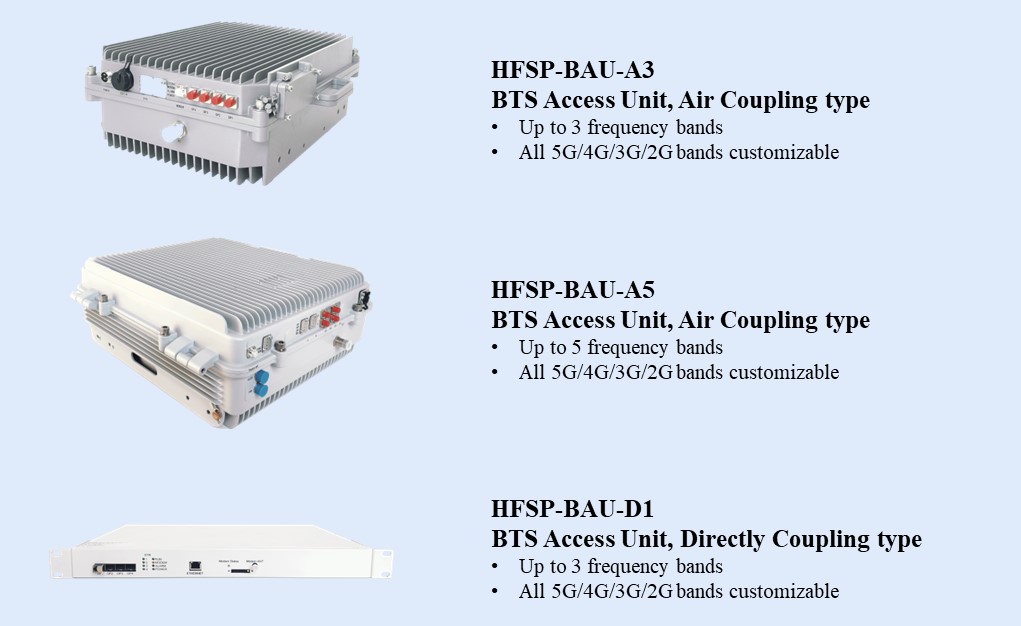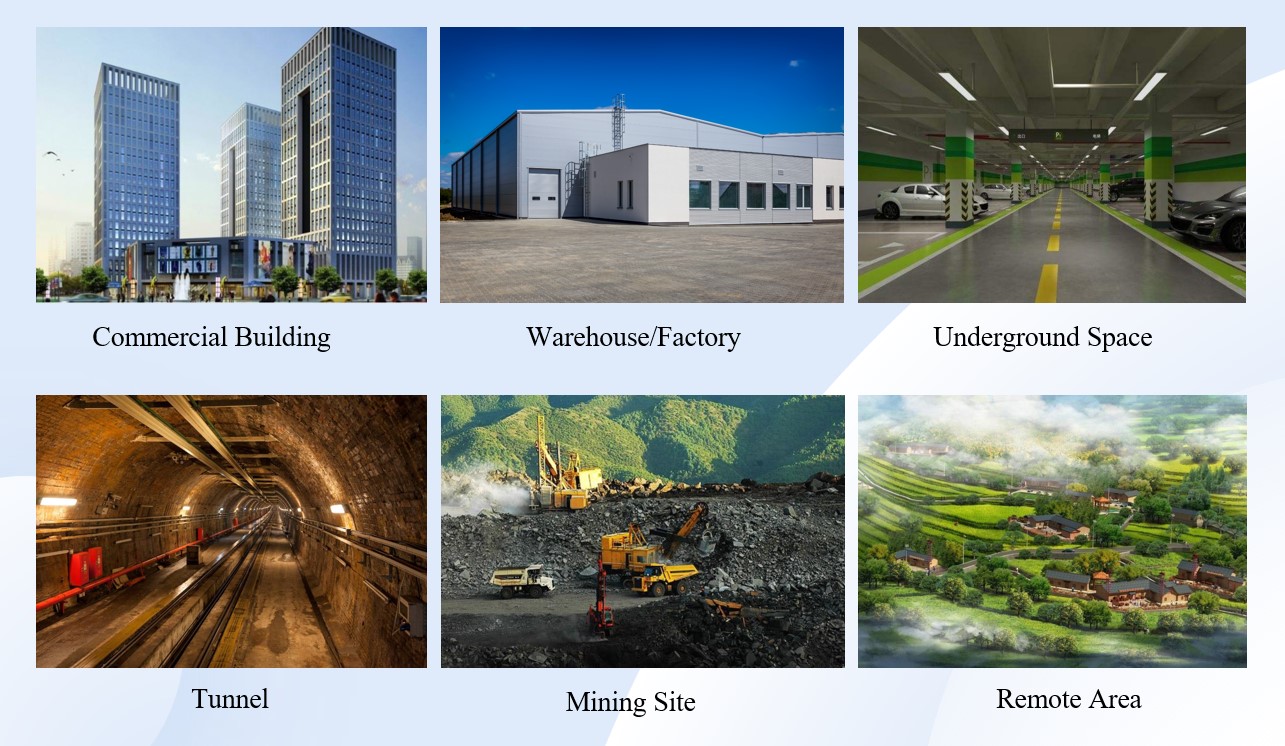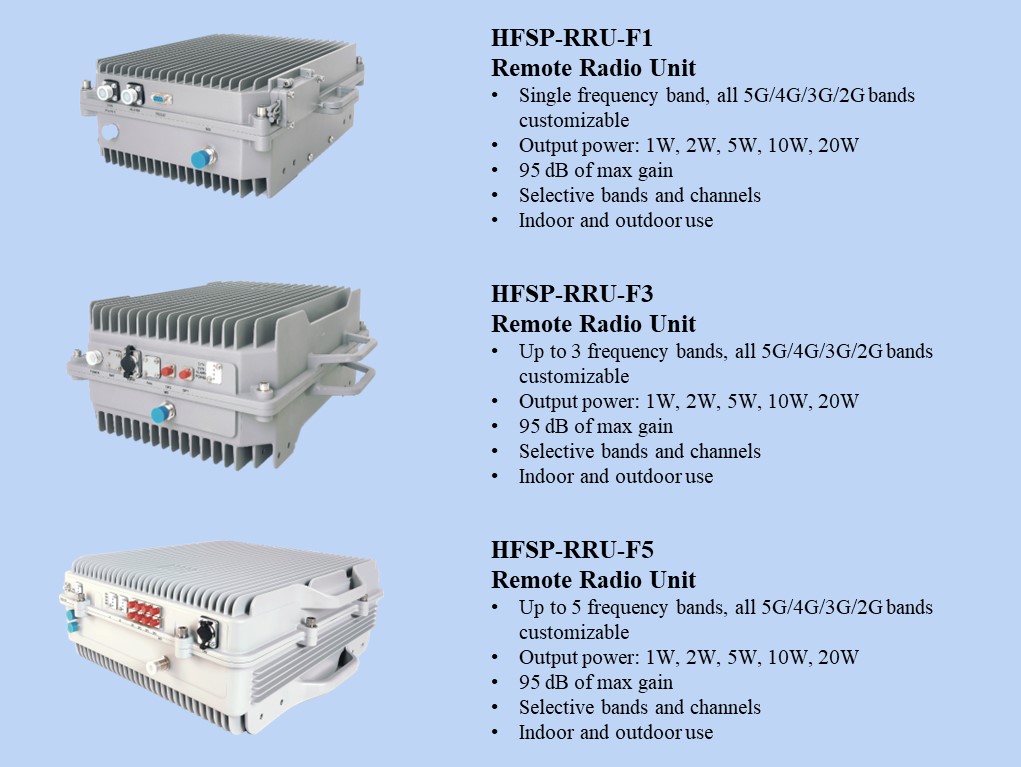HSFP Series - Digital Fiber Optic Signal Repeater
Introduction
The HFSP series is digital fiber optic repeater which extends cellular signal coverage to areas with poor or simply no signal by fiber optic transmission. The repeater comprises of BTS Access Unit (BAU) and remote radio units (RRU). The Access Unit digitizes the signal received from BTS, converts it into CPRI standard interface, and transmits it to RRU through fiber optic. The RRU receives the data through the CPRI standard interface, converts it into RF signal, amplifies after broadcasts the signal to target coverage areas. One Access Unit has four optical ports. A single optical port can connect eight RRU in chain mode, and four optical ports can connect up to 32 RRUs. The networking mode is flexible, including point-to-point networking, star networking, Daisy chain networking and hybrid networking, etc., which can form a distributed coverage system for large-scale coverage. It is especially suitable for long distance belt covering area.
Compared with the traditional analog optical fiber repeater, the digital optical fiber repeater has the advantages of larger output power, lower noise coefficient, longer transmission distance, no interference to the base station when multiple RRUs are deployed, more flexible networking, and adjustable delay of the overlapping coverage area of the RRUs.
According to different ways to access to BTS signal, the Access Unit can be divided into two types: Direct Coupling type, and Air Coupling type. The former connects to BTS directly through cable, and the latter accesses to BTS signal from the air through donor antenna.
Network diagram 1: Fiber optic repeater - Air Coupling mode

Network diagram 2: Fiber optic repeater - Direct Coupling mode

Models of BAUs and RRUs
BAU (BTS Access Unit)

RRU (Remote Radio Unit)
Main Features
1. ALC (Automatic Level Control) and no-load protection function to improve the safety of equipment.
2. High-power and high-linear amplifier technology is adopted to ensure that the signal is not distorted after being amplified, and the background noise elevation of the base station is reduced.
3. Aluminum alloy chassis meets IP65 protection grade, high heat dissipation design, for indoor and outdoor deployment.
4. Supports multiple networking modes such as chain, star, ring, and hybrid.
5. Supports local and remote network monitoring functions, including active alarm, query, and parameter setting (optional).
6. Supports connecting to the network management platform in wired or wireless mode (optional).
Highlights
Application Scenarios

Major Parameters
|
Items |
Parameters |
Note |
|
|
BAU |
RRU |
||
|
Frequency (MHz) |
5G NR: n1/n3/n28/n38/n40/n41/n78/n79 |
Frequency bands could be customized. Support up to five bands in one repeater |
|
|
4G LTE FDD: B1/B2/B3/B4/B5/B7/B8/B9/B10/B20/B25/B26/B28/B66/B70 4G TD-LTE: B34/B38/B39/B40/B41 3G, 2G, NB-IoT, eMTC |
|||
|
Max. Output Power (dBm) |
Uplink: 13±2 (30dBm); 30±2 (37dBm or above) |
Downlink: 30/37/40/43±2 |
|
|
Max. Gain (dB) |
95±2 (Air coupling); 52±2 (Direct coupling) |
|
|
|
Maximum Input Power(dBm) |
-10 |
|
|
|
Gain Adjustment Range (dB) |
≥30 |
|
|
Network Diagram
Scenario 1: When the isolation condition and reception signal is not good, and the coverage area is big, digital fiber optic repeater is recommended for cellular signal coverage.

Scenario 2: For underground area (parking lot, tunnel, etc.) that is big, it’s recommended to adopt fiber optic repeater with multiple remote units for cellular signal coverage.

Scenario 3: For remote area that’s far from signal source such as a remote village, mining site, factory, construction site, etc., the fiber optic repeater is an ideal solution, with access unit deployed near the signal source, and remote units deployed in the coverage area which is far way from signal source.











